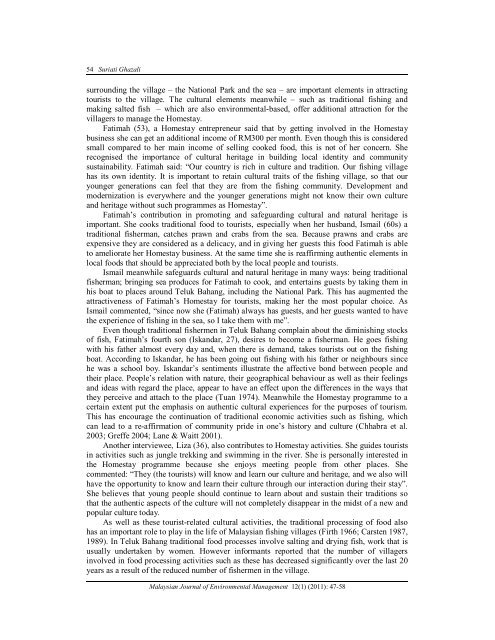Safeguarding Natural and Cultural Heritage - Malaysia Journal of ...
Safeguarding Natural and Cultural Heritage - Malaysia Journal of ...
Safeguarding Natural and Cultural Heritage - Malaysia Journal of ...
Create successful ePaper yourself
Turn your PDF publications into a flip-book with our unique Google optimized e-Paper software.
54 Suriati Ghazali<br />
surrounding the village – the National Park <strong>and</strong> the sea – are important elements in attracting<br />
tourists to the village. The cultural elements meanwhile – such as traditional fishing <strong>and</strong><br />
making salted fish – which are also environmental-based, <strong>of</strong>fer additional attraction for the<br />
villagers to manage the Homestay.<br />
Fatimah (53), a Homestay entrepreneur said that by getting involved in the Homestay<br />
business she can get an additional income <strong>of</strong> RM300 per month. Even though this is considered<br />
small compared to her main income <strong>of</strong> selling cooked food, this is not <strong>of</strong> her concern. She<br />
recognised the importance <strong>of</strong> cultural heritage in building local identity <strong>and</strong> community<br />
sustainability. Fatimah said: “Our country is rich in culture <strong>and</strong> tradition. Our fishing village<br />
has its own identity. It is important to retain cultural traits <strong>of</strong> the fishing village, so that our<br />
younger generations can feel that they are from the fishing community. Development <strong>and</strong><br />
modernization is everywhere <strong>and</strong> the younger generations might not know their own culture<br />
<strong>and</strong> heritage without such programmes as Homestay”.<br />
Fatimah’s contribution in promoting <strong>and</strong> safeguarding cultural <strong>and</strong> natural heritage is<br />
important. She cooks traditional food to tourists, especially when her husb<strong>and</strong>, Ismail (60s) a<br />
traditional fisherman, catches prawn <strong>and</strong> crabs from the sea. Because prawns <strong>and</strong> crabs are<br />
expensive they are considered as a delicacy, <strong>and</strong> in giving her guests this food Fatimah is able<br />
to ameliorate her Homestay business. At the same time she is reaffirming authentic elements in<br />
local foods that should be appreciated both by the local people <strong>and</strong> tourists.<br />
Ismail meanwhile safeguards cultural <strong>and</strong> natural heritage in many ways: being traditional<br />
fisherman; bringing sea produces for Fatimah to cook, <strong>and</strong> entertains guests by taking them in<br />
his boat to places around Teluk Bahang, including the National Park. This has augmented the<br />
attractiveness <strong>of</strong> Fatimah’s Homestay for tourists, making her the most popular choice. As<br />
Ismail commented, “since now she (Fatimah) always has guests, <strong>and</strong> her guests wanted to have<br />
the experience <strong>of</strong> fishing in the sea, so I take them with me”.<br />
Even though traditional fishermen in Teluk Bahang complain about the diminishing stocks<br />
<strong>of</strong> fish, Fatimah’s fourth son (Isk<strong>and</strong>ar, 27), desires to become a fisherman. He goes fishing<br />
with his father almost every day <strong>and</strong>, when there is dem<strong>and</strong>, takes tourists out on the fishing<br />
boat. According to Isk<strong>and</strong>ar, he has been going out fishing with his father or neighbours since<br />
he was a school boy. Isk<strong>and</strong>ar’s sentiments illustrate the affective bond between people <strong>and</strong><br />
their place. People’s relation with nature, their geographical behaviour as well as their feelings<br />
<strong>and</strong> ideas with regard the place, appear to have an effect upon the differences in the ways that<br />
they perceive <strong>and</strong> attach to the place (Tuan 1974). Meanwhile the Homestay programme to a<br />
certain extent put the emphasis on authentic cultural experiences for the purposes <strong>of</strong> tourism.<br />
This has encourage the continuation <strong>of</strong> traditional economic activities such as fishing, which<br />
can lead to a re-affirmation <strong>of</strong> community pride in one’s history <strong>and</strong> culture (Chhabra et al.<br />
2003; Greffe 2004; Lane & Waitt 2001).<br />
Another interviewee, Liza (36), also contributes to Homestay activities. She guides tourists<br />
in activities such as jungle trekking <strong>and</strong> swimming in the river. She is personally interested in<br />
the Homestay programme because she enjoys meeting people from other places. She<br />
commented: “They (the tourists) will know <strong>and</strong> learn our culture <strong>and</strong> heritage, <strong>and</strong> we also will<br />
have the opportunity to know <strong>and</strong> learn their culture through our interaction during their stay”.<br />
She believes that young people should continue to learn about <strong>and</strong> sustain their traditions so<br />
that the authentic aspects <strong>of</strong> the culture will not completely disappear in the midst <strong>of</strong> a new <strong>and</strong><br />
popular culture today.<br />
As well as these tourist-related cultural activities, the traditional processing <strong>of</strong> food also<br />
has an important role to play in the life <strong>of</strong> <strong>Malaysia</strong>n fishing villages (Firth 1966; Carsten 1987,<br />
1989). In Teluk Bahang traditional food processes involve salting <strong>and</strong> drying fish, work that is<br />
usually undertaken by women. However informants reported that the number <strong>of</strong> villagers<br />
involved in food processing activities such as these has decreased significantly over the last 20<br />
years as a result <strong>of</strong> the reduced number <strong>of</strong> fishermen in the village.<br />
<strong>Malaysia</strong>n <strong>Journal</strong> <strong>of</strong> Environmental Management 12(1) (2011): 47-58


